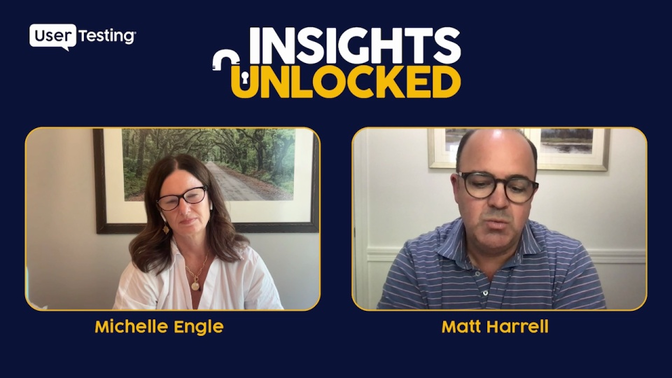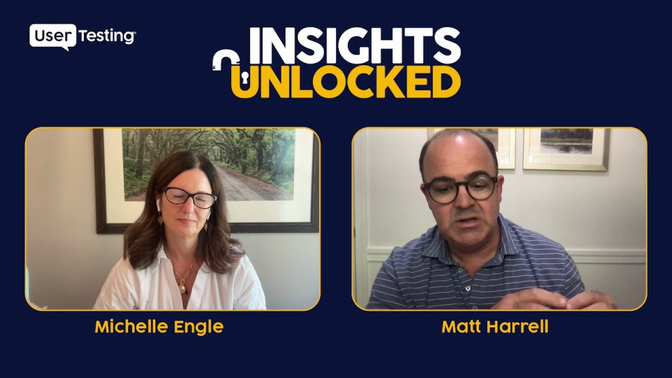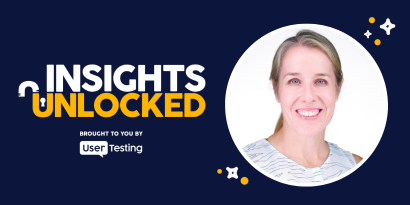
Episode 139 | October 07, 2024
Aligning user research with business goals for product success
Learn how Matt Harrell of Givebacks turns user research into actionable insights, aligns research with business goals, and drives product improvements.
Aligning user research with business goals for product success
In today’s competitive digital landscape, creating a product that meets customer needs isn’t just about innovation—it’s about listening to your users. But how do you translate user feedback into meaningful product decisions?
According to Matt Harrell, Co-founder and VP of Customer Experience at Givebacks, the answer lies in aligning research with business goals.
You really can’t separate product from the customer experience, Matt shared in his Insights Unlocked podcast interview with Michelle Engle, UserTesting's Chief Product Officer.
In this blog post, we’ll break down key takeaways from Matt’s interview, focusing on how to prioritize user research, turn feedback into actionable insights, and maintain a consistent user experience through effective governance.
Aligning user research with business objectives
A key theme of the conversation is the importance of aligning user research with quarterly OKRs (Objectives and Key Results). This ensures that research efforts not only gather valuable insights but also support business goals. Matt’s team at Givebacks follows this practice to avoid getting overwhelmed by research requests and focus on initiatives that drive business impact.
“When we know which initiative we’re working on for the quarter, we break that down into specific research goals,” Harrell explained. “By tying it to OKRs, we ensure our research efforts are not only insightful but also driving the business forward.”
"By tying research to OKRs, we ensure our efforts are not only insightful but also driving the business forward." – Matt Harrell

Creating actionable research reports
One of the most effective ways to communicate research findings is through structured reports that break down the key insights, metrics, and user feedback. Matt shared that his team creates detailed decks that include user responses, charts, and highlight reels to make the findings easy to digest.
“I always create a highlight reel,” Harrell noted. “It’s one thing to read data, but when stakeholders can watch users actually struggle with something, it really drives the point home.”
These reports are critical for getting buy-in from stakeholders across the company, especially those outside the customer-facing teams. Sharing research results clearly and effectively ensures that insights lead to real product improvements.
"It’s one thing to read data, but when stakeholders can watch users actually struggle, it really drives the point home." – Matt Harrell
The role of governance in user experience consistency
In addition to focusing on user feedback, Matt emphasized the importance of governance in maintaining a cohesive user experience across all touchpoints. At Givebacks, the team uses governance strategies to ensure consistency in design and messaging, particularly in their in-app tools.
“We treat every new in-app guide or digital tool as important as a new product release,” Matt explained. “It’s about making sure every interaction with the user feels native to the overall experience.”
By building cross-functional collaboration around these initiatives, Givebacks ensures that every part of the customer journey remains seamless and aligned with the company’s goals.
"We treat every new in-app guide as important as a new product release." – Matt Harrell
Sharing the voice of the customer across teams
To keep teams aligned with customer needs, Matt creates and regularly shares a Voice of Customer (VOC) report. These bi-weekly reports compile feedback from various sources, including NPS scores, customer support trends, and product data, making it easier for non-customer-facing teams to stay connected to the customer’s voice.
“The goal is to have everyone understand the pulse of the customer,” Harrell said. “We want to make sure our teams are always thinking about how their decisions affect the end-user experience.”
This approach ensures that customer feedback influences decisions at every level of the company, from development to marketing.
"The goal is to have everyone understand the pulse of the customer." – Matt Harrell

Conclusion: focus on what matters most
For businesses looking to improve their products, Matt offers a clear roadmap: prioritize research based on business goals, communicate insights effectively, and ensure consistency through governance. By following these practices, you can turn user feedback into actionable insights that drive both customer satisfaction and business success.
“The key is making sure the research you do is focused on what matters most to your customers and your business,” Harrell concluded.
"The key is making sure the research you do is focused on what matters most to your customers and your business." – Matt Harrell
Episode links:
- Givebacks: Matt's company that supports nonprofits through online giving and everyday purchases
- Matt mentioned that he is active on LinkedIn
- Pendo: A tool Matt referred to for managing in-app guides and ensuring consistent user experience
- What is UX Research?: This page breaks down different types of user research methods, including attitudinal and behavioral research, and offers insights into how these methods can inform product development
- The Complete Guide to User Interviews: This guide explores various types of user interviews, from generative to contextual, and provides tips on conducting effective interviews that yield actionable insights—similar to the strategies discussed by Matt Harrell
- How to Include User Research in Early Product Development: This page highlights the importance of integrating user research early in the product development process to ensure products are designed with customer needs in mind, aligning with the OKR-based approach Matt mentioned. (https://www.usertesting.com/blog/how-include-user-research-early-product-development)
- Setting Clear Objectives for Your UX Research: This resource helps teams structure research goals to obtain specific, actionable insights—something Matt emphasized in his interview about research alignment and prioritization
- An Essential Guide to Research Operations: This guide explains how a structured research operations strategy can help manage research activities and make insights easily accessible across teams, resonating with Matt’s approach to sharing VOC reports.









